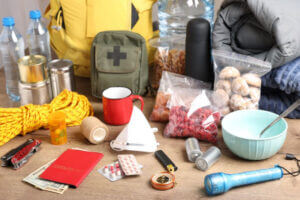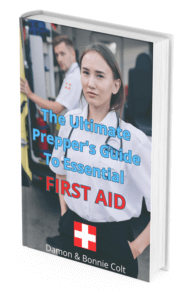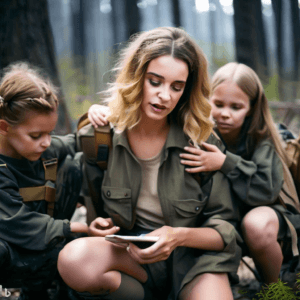When it comes to preparing for survival scenarios, basic prepping isn’t just about stockpiling supplies in your home. It involves making comprehensive preparations for events that might require you to abandon your home and “bug out” to the wilderness or another location. Whether it’s a natural disaster, a social unrest situation, or any other emergency, being prepared to grab your bug out bag and go is essential.
A well-prepared bug out bag is a critical component of your survival strategy, and it should be tailored to meet the needs of each member of your family. In this guide, we’ll explore the key components of a bug out bag and provide practical examples to help you build a reliable and effective kit for emergency situations.
Bug Out Bag Essentials: What You Need to Survive
Your bug out bag should contain essential items that are crucial for your survival and safety. While it might be tempting to pack your favorite items, the focus should be on necessities that will keep you or any of your family alive and well-prepared. Here’s how to get started:
Selecting the Right Bug Out Bag
Start by choosing a durable and lightweight bug out bag. The last thing you want is for your bag to break or not have enough room for essential supplies. Ensure it can withstand the rigors of your journey and has ample storage space. Look for bags with multiple compartments and reinforced stitching.
There are dozens of designs on bug-out-bags and many are that are advertised and sold are smallish clip-ons. You need to have a serious think about that – a slightly bigger bag with more compartments will be better – because this bag may be with you for a long time and needs to hold everything that is vitally important and essential for your survival. So don’t scrimp on it!
Inside your bug out bag, include important documentation, identification, and some cash. These items are crucial for identification and financial needs during a crisis. Additionally, consider including copies of important documents, such as passports, driver’s licenses, and medical records, in waterproof bags for extra protection. This includes everyone in your family. It’s not good enough to say “Mum and Dad have your ID papers and passports etc in their kit…’ – no – your kids need to know the vital importance of their documentation, and they need to carry their own stuff and take responsibility for it too.
They could be at school when an emergency strikes and it could be days until you are reunited.
Do you really want them to have no ID to prove their identity, or not have any emergency cash on hand? Surely not.
Hydration and Nutrition
In survival situations, access to food and water will be uncertain. Carrying water can be heavy, so plan to carry enough to reach another water source. Include purification methods such as tablets or drops or purification straws, allowing you to safely drink from natural water sources.
It’s essential to prioritize hydration as you may be exerting more energy than usual while hiking or navigating the elements. Ensure you pack more water than you think you’ll need, and consider a bug out bag with a built-in water bladder for convenient access. To further expand your water-carrying capacity, pack collapsible water containers that can be filled from natural sources.
When it comes to nutrition, focus on lightweight, high-calorie foods that are non-perishable and won’t attract wildlife. Energy bars, beef jerky, dehydrated fruits, and canned goods are excellent choices. These items can be consumed directly or warmed up over a fire if you have the means to start one. To ensure a balanced diet, include a variety of food items that offer essential nutrients. Pack Multivitamins and check expiry ages of all those supplies regularly.
Safety and Protection
Your safety can be compromised by various factors, including the weather, wildlife, or human threats. Prepare accordingly:
- Clothing: Pack appropriate clothing for varying weather conditions, using layers for versatility. This allows you to adjust your clothing as needed. Include items like moisture-wicking base layers, insulating mid-layers, waterproof outer layers, and extra socks and underwear. Don’t forget sturdy, comfortable footwear suitable for hiking long distances.
- Shelter: Include a tent or tarp for protection from rain and wind. Ensure your sleeping bag can withstand low temperatures if you’re in a cold climate. In addition to a sleeping bag, consider a compact sleeping pad or insulation layer to provide insulation from the cold ground.
- Self-Defense: Consider self-defense measures such as pepper spray, firearms, or a multipurpose knife. Practice using these tools before a survival situation that may include civil unrest, possible looting and danger to you or your family’s safety to ensure you are skilled in using weapons to defend yourself. If you decide to carry a firearm, make sure you comply with all local laws and regulations regarding firearms ownership and transportation. Even more importantly – make sure you know how to use it safely so you can protect yourself and your family without shooting yourself in the foot the first time to use a gun!
While self-defense tools can provide protection, it’s also important to have knowledge and skills in situational awareness and conflict avoidance. Your ability to make informed decisions and avoid potentially dangerous situations is a crucial aspect of personal safety during a crisis. Just because you have a firearm and know how to use it does not mean you can abandon basic safety precautions. The idea is to have a gun as the very last resort, so practise avoiding conflict and simply staying away from dangerous situations if you can.
Crisis and civil unrest situations never play out like you see in the movies or in TV programs. Be cautious, avoid conflict, stay in the shadows and protect your family.
Useful Gadgets and Tools
Tools and gadgets can significantly improve your bug out emergency kit. Here are some helpful items to consider:
- Multi-tool: A versatile tool with various functions, such as pliers, screwdrivers, a knife, and a saw. Look for a high-quality, durable multi-tool that can withstand heavy use.
- Solar lights: Collapsible solar lights are a valuable addition to your bug out bag. Attach them to a MOLLE system on the outside of your bag to charge during the day while you’re on the move. These lights can provide illumination at night around your campsite.
- Fire-starting tools: Pack reliable fire-starting equipment like flint and steel, a fire starter, or waterproof matches. Ensure you also carry fire tinder, such as cotton balls soaked in petroleum jelly, to assist with fire ignition in challenging conditions.
- Navigation aids: Include physical maps and a compass for navigation in case GPS systems fail. Familiarize yourself with map reading and basic compass use to navigate effectively. If you have access to a topographic map of the area you’ll be traversing, it can provide valuable information about terrain and landmarks.
- Communication devices: Two-way radios with a long communication range can help you stay in contact with your group. Solar chargers and portable power banks can keep your electronic devices, such as smartphones and GPS devices, operational. Make sure to pack charging cables compatible with your devices.
- All-weather radio: Consider adding an all-weather radio, preferably with a hand-crank option, to your bug out bag. This radio can receive important emergency alerts and broadcast critical information. A NOAA Weather Radio, in particular, can provide updates on weather conditions and warnings.
- Repair and maintenance tools: Include basic tools for repairing gear and equipment, such as a sewing kit, duct tape, and a multi-purpose repair tool. These items can extend the lifespan of your gear and help you address unexpected equipment failures.
Medical Supplies for First Aid
Injuries can and will happen, and access to medical care may be limited during a survival situation. Check out our excellent guide “The Ultimate Guide For Essential First Aid” to be better prepared. Ensure you have comprehensive medical supplies:
- Compact first aid kit: Purchase a ready-made kit and customize it with personal medications, prescription information, and additional items specific to your family’s needs. Your customized kit should account for any allergies, chronic medical conditions, or unique health concerns.
- First aid guide: Include our Ultimate Guide For Essential First Aid as a booklet with instructions that you have printed out and laminated for basic medical procedures. Don’t rely on having a electronic copy on your phone or in the ‘cloud’, your phone may not be working, the battery drained, anything can happen. Your Ultimate Guide for Essential First Aid should always be a printed booklet you can use in any situation, no matter how dire. Familiarize yourself with the contents of our guide and practice essential first aid techniques regularly with your family.
- Prescription medications: If any of your family members require prescription medications, ensure you have an ample supply. Rotate these medications regularly to prevent expiration.
- Personal hygiene items: Include personal hygiene items such as toothbrushes, toothpaste, soap, and hand sanitizer. Maintaining hygiene is crucial for preventing infections and promoting overall well-being.
- Sanitation supplies: Pack waste disposal bags or a portable toilet kit. Proper waste disposal is essential for maintaining hygiene and preventing contamination of water sources.
- Feminine sanitary products: make sure you have a sufficient supply of sanitary products if any of your family needs pads, tampons, cloths, cups and a large supply of disinfectant wet wipes if little or no water is available to keep your hands and private parts clean.
This may be a sensitive subject for some but you need to get over yourselves and discuss this openly, frankly and clearly so a sudden bout of period does not turn into a traumatic event for any of your family.
- Trauma supplies: Include trauma supplies like tourniquets, hemostatic dressings, and Israeli bandages for severe bleeding control. Ensure you know how to use these items safely and effectively.
- Prescription eyewear: If anyone in your family requires prescription eyewear, ensure you have spare glasses or contact lenses in your bug out bag.
- Emergency dental care: Consider adding dental care items like dental floss, temporary dental cement, and oral analgesics for dental emergencies.
Preparing Your Bug Out Bag
Practicing with your bug out bag is crucial. Take it on a weekend camping trip with your family and simulate survival situations to identify any missing items or areas for improvement. Use this opportunity to test your gear and familiarize yourself with its functionality.
Some of the preppers we are in regular contact with and exchange ideas with told us they maintain multiple bug out bags—one at home, one in the office, and one in their vehicle. This strategy minimizes the risk of you or any of your family being caught unprepared in unexpected situations.
Conclusion: Your Path to Preparedness
Building a reliable bug out bag is a vital step in preparing for emergency scenarios. While it’s essential to have supplies at home, a well-equipped bag at your work, in your car or at school for your kids can mean the difference between survival and vulnerability when you need to evacuate.
By carefully selecting the right gear and practicing with your bug out bag regularly, you can ensure that you and your family are prepared for whatever challenges the future may hold.
Remember, preparation is not a one-time event—it’s an ongoing commitment to your safety and well-being. Stay vigilant, stay prepared, and stay safe. In uncertain times, your bug out bag may juts become your lifeline, offering you the tools and resources you need to navigate through adversity like a natural disaster or serious civil unrest and emerge on the other side with confidence and resilience.
Incorporating these considerations and items into your bug out bag will help you create a comprehensive and effective emergency kit tailored to your family’s unique needs. Being well-prepared can provide peace of mind and increase your chances of surviving and thriving in any situation.
Missed part 3 of your Survival Prepping 101 series? Here is it: Part 3







